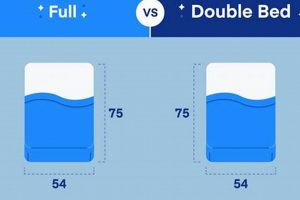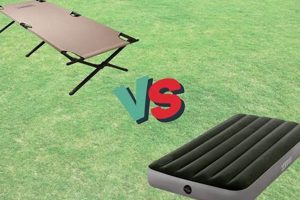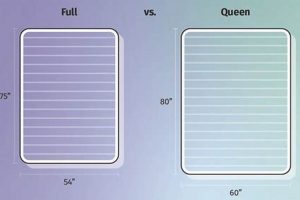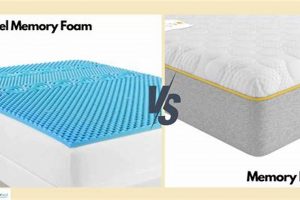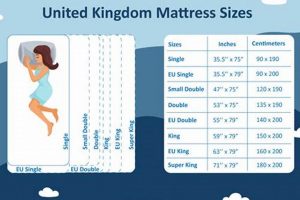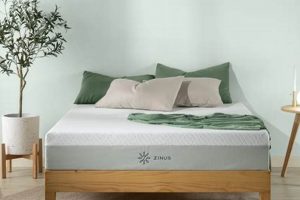A cushioning layer placed atop a mattress to enhance comfort and modify its feel exists in two primary forms: a thinner textile layer and a more substantial, often thicker, supplementary surface. The former, secured with elastic or fitted edges, provides a minimal adjustment to the sleeping surface. The latter offers a more significant alteration to the mattress’s characteristics, potentially impacting support and overall comfort levels. An example of the thinner variety would be a quilted cotton layer, while the thicker could be composed of memory foam or latex.
Selecting an appropriate overlay can extend the lifespan of a mattress by protecting it from wear and tear. It can also provide a cost-effective alternative to replacing an entire mattress when seeking enhanced comfort. Historically, similar bedding enhancements were utilized to improve the insulation and cleanliness of rudimentary sleeping surfaces.
This exploration will delve into the distinguishing features, benefits, and drawbacks of each option, providing a framework for informed decision-making when selecting a bedding enhancement to optimize sleep quality and mattress longevity. Key aspects examined will include materials, thickness, maintenance, and cost considerations.
Selection Guidance
The following considerations offer guidance when evaluating supplementary bedding options for enhanced sleep and mattress longevity.
Tip 1: Assess Existing Mattress Condition: Before selecting a supplementary layer, thoroughly evaluate the current state of the mattress. If the mattress exhibits significant sagging or internal damage, a thicker option may offer more substantial support. However, if the mattress is generally in good condition, a thinner, more subtle option may suffice for added comfort.
Tip 2: Evaluate Material Properties: Different materials offer varying levels of support, temperature regulation, and durability. Memory foam conforms closely to the body, providing pressure relief, while latex offers a more responsive and buoyant feel. Cotton and down alternatives provide enhanced breathability. Choose a material based on individual sleep preferences and needs.
Tip 3: Consider Thickness and Profile: The thickness will directly impact the degree of comfort and support alteration. Thicker profiles typically offer greater pressure relief and can significantly alter the feel of the mattress. Thinner profiles provide a more subtle change, primarily enhancing comfort without drastically altering support.
Tip 4: Evaluate Maintenance Requirements: Different materials require different cleaning protocols. Some are machine-washable, while others require spot cleaning or professional cleaning services. Consider the long-term maintenance demands before making a selection.
Tip 5: Budgetary Considerations: Prices vary considerably based on material, thickness, and brand reputation. Establish a budget prior to beginning the selection process to narrow down the available options and avoid overspending.
Tip 6: Trial Period and Return Policies: Whenever possible, opt for products that offer a trial period or a lenient return policy. This allows for real-world testing and ensures satisfaction with the selected bedding enhancement.
Careful consideration of these factors will facilitate an informed decision, leading to improved sleep quality and extended mattress life. The suitability of either supplementary layer will vary depending on individual needs and preferences.
The subsequent section will explore common misconceptions regarding supplementary bedding options and provide clarification for informed decision-making.
1. Thickness and profile
Thickness and profile represent a critical differentiating factor. The former commonly exhibits a range between one to four inches, providing a substantial modification to the existing sleep surface. The latter, conversely, typically measures less than one inch in thickness, functioning primarily as a protective layer or a subtle enhancement to surface comfort. This disparity directly influences the degree of support and pressure relief afforded to the sleeper.
For example, individuals seeking significant pressure relief in areas such as the hips or shoulders might benefit from a thicker, memory foam option that contours to the body’s curves. Conversely, those primarily concerned with protecting their mattress from spills or allergens, or those seeking only a slight increase in plushness, would likely find a thinner, quilted cotton variety more suitable. The profile also influences the overall height of the bed, which may be a consideration for individuals with mobility limitations.
In essence, the thickness and profile directly determine the degree to which the existing mattress’s characteristics are altered. A thicker option functions as a more significant intervention, potentially correcting deficiencies in the underlying mattress’s support or comfort levels. A thinner option serves primarily as a supplementary layer, providing minimal change to the overall feel of the sleeping surface. Therefore, careful assessment of individual needs and preferences is essential when evaluating these characteristics.
2. Material composition
The materials used in construction dictate functional characteristics and longevity. Selection of these materials significantly influences the comfort, support, temperature regulation, and durability of these bedding enhancements.
- Memory Foam: Conforming Support
Memory foam, often composed of polyurethane with additional chemicals increasing its viscosity and density, is known for its ability to conform to the body’s shape. This property allows for pressure point relief and spinal alignment. However, memory foam can retain heat, potentially leading to discomfort for some sleepers. In this context, memory foam is primarily found in thicker options designed to substantially alter the feel of a mattress. Example: Viscoelastic polyurethane foam.
- Latex: Resilient Responsiveness
Latex, derived from either natural rubber sap or synthetic materials, provides a resilient and responsive sleeping surface. Natural latex is hypoallergenic and breathable, promoting airflow and regulating temperature. Latex is typically more durable than memory foam. This material can be found in both thicker and thinner variants, offering a balance of comfort and support. Example: Dunlop or Talalay processed latex.
- Down and Feather: Plush Comfort
Down and feather fillings, commonly found in thinner versions, offer a plush and luxurious feel. However, these materials provide minimal support and may require frequent fluffing to maintain their loft. Individuals with allergies may need to consider hypoallergenic alternatives. These are primarily used to enhance comfort rather than alter the support characteristics of the mattress. Example: Goose down or duck feathers.
- Polyester and Cotton Blends: Affordable Utility
Polyester and cotton blends are frequently used in less expensive options, often featuring a quilted construction. These materials are easy to clean and maintain, but they offer less support and durability compared to memory foam or latex. They primarily function as a protective layer or a subtle enhancement to surface comfort. Example: Quilted polyester fiberfill.
The choice of material fundamentally dictates the performance characteristics of the overlay. Understanding the properties of each material allows for a more informed decision, aligning the selection with individual needs and preferences regarding support, temperature regulation, and durability. The materials utilized often dictate the primary function of the bedding enhancement, whether that be substantial support alteration or simple mattress protection.
3. Support provision
The degree of support provided by a supplementary mattress layer is a critical consideration when evaluating options to enhance sleep quality and address discomfort. The inherent design and materials directly influence the level of support offered, and subsequently, the impact on spinal alignment and pressure point relief.
- Thickness and Density Correlation to Support
Thicker options, particularly those constructed from high-density materials such as memory foam or latex, generally provide greater support compared to thinner alternatives. For example, a four-inch memory foam topper can effectively redistribute weight, reducing pressure on areas like the hips and shoulders, potentially alleviating pain and improving spinal alignment. A thinner, fiber-filled option will offer minimal support redistribution.
- Material Responsiveness and Spinal Alignment
The responsiveness of the material also plays a crucial role. Latex, with its inherent elasticity, provides a more dynamic support, adapting to movements throughout the night. This can be advantageous for individuals who change sleeping positions frequently. In contrast, memory foam conforms to the body’s shape, providing consistent support in a fixed position. Improper support can lead to spinal misalignment and exacerbate existing back pain.
- Addressing Mattress Sagging and Support Deficiencies
A primary function of a thicker, supportive overlay is to compensate for sagging or loss of support in an aging mattress. By adding a layer of responsive material, the supplementary layer can restore a more even and supportive sleeping surface. This can be particularly beneficial for individuals who are not yet ready to replace their entire mattress. The lack of support offered by a thinner mattress layer is not ideal for mitigating sagging or indentations.
- Impact on Different Sleep Positions
The ideal level of support varies depending on preferred sleep position. Side sleepers generally require more pressure relief in the shoulder and hip areas, benefiting from a conforming and supportive layer. Back sleepers need consistent support across the entire back to maintain spinal alignment. Stomach sleepers often require a firmer surface to prevent excessive arching of the spine. Consideration of sleep position is essential when evaluating the suitability of support provided.
The interaction between supplementary bedding and the underlying mattress significantly influences the overall level of support. While a supportive overlay can enhance comfort and alleviate pressure points, it cannot fully compensate for severe deficiencies in the underlying mattress’s support structure. The effectiveness in addressing support-related issues relies on selecting an appropriate material and thickness that aligns with individual needs and the condition of the existing mattress.
4. Heat regulation
Maintaining a comfortable sleeping temperature is essential for achieving restful sleep. The materials and construction of mattress enhancements significantly influence heat retention and airflow, thereby affecting overall sleep quality. This section explores the critical facets of heat regulation in relation to different mattress enhancements.
- Material Breathability
The intrinsic breathability of the material directly impacts heat dissipation. Natural materials such as cotton, wool, and latex generally exhibit superior breathability compared to synthetic materials like memory foam. Open-cell memory foam represents an attempt to mitigate heat retention by promoting airflow through its structure, but it typically does not match the breathability of natural alternatives. For example, a wool mattress layer can wick away moisture and allow for air circulation, reducing the likelihood of overheating during the night, while a conventional memory foam option may trap heat, leading to discomfort.
- Thickness and Airflow Restriction
The thickness and density of the mattress enhancement can impede airflow, contributing to heat build-up. Thicker memory foam options, in particular, may restrict air circulation around the body, increasing the likelihood of overheating. Conversely, thinner options, especially those constructed from breathable materials, allow for greater airflow and more effective heat dissipation. For example, a thin cotton layer provides minimal insulation and allows for natural ventilation, preventing excessive heat accumulation.
- Construction Techniques
The method of construction influences the overall breathability and heat regulation properties. Quilted designs, commonly found in thinner options, can promote airflow compared to solid, dense structures. Additionally, the use of ventilated designs or perforated materials can further enhance airflow. An example includes a mattress layer with strategically placed ventilation channels to facilitate air circulation and reduce heat retention. Some mattress layer incorporates Outlast technology, originally developed by NASA, which absorbs and releases heat to maintain a consistent temperature.
- Impact of Sleep Position
Sleep position influences the degree of contact between the body and the mattress enhancement, thereby affecting heat retention. Individuals who sleep on their stomach or back have greater surface area contact with the sleeping surface compared to side sleepers. This increased contact can lead to greater heat build-up, particularly with materials that have poor breathability. Therefore, sleep position should be considered when selecting a mattress enhancement with appropriate temperature regulation properties. For instance, stomach sleepers may benefit from a breathable latex option to minimize heat retention.
Heat regulation is a critical factor in determining the comfort and suitability of these products. The choice of material, thickness, and construction technique all contribute to the overall thermal performance. Understanding these factors enables consumers to select a option that effectively manages heat and promotes a comfortable sleep environment, therefore avoiding discomfort and helping to achieve a good night rest.
5. Cost differential
A significant divergence in price exists between these two bedding enhancements, primarily stemming from variations in material composition, construction complexity, and intended functionality. Thinner, basic textile versions typically command a lower price point due to simpler manufacturing processes and the use of less expensive materials, such as polyester or cotton blends. Conversely, thicker options, often incorporating advanced materials like memory foam or latex and featuring more intricate construction, incur higher production costs, reflected in a comparatively higher retail price. This difference can be considerable, potentially ranging from a few tens of dollars for basic options to several hundreds for premium varieties. A practical example would be a simple quilted pad costing $30-$50, while a high-density memory foam option could exceed $300.
The cost differential also impacts the perceived value proposition. While a less expensive option may offer basic protection or a slight comfort enhancement, it may lack the durability and support characteristics of its pricier counterpart. Consequently, a higher initial investment in a more substantial option may prove more cost-effective in the long run, particularly for individuals seeking significant improvements in sleep quality or addressing specific support needs. Furthermore, the longevity of the selected product influences overall cost-effectiveness. A lower-priced option may require more frequent replacement, negating any initial savings. Conversely, a higher-quality version, while initially more expensive, may provide years of reliable service, reducing the need for future replacements.
In summary, the cost differential between these two products is a direct consequence of variations in materials, construction, and intended function. This cost disparity should be carefully weighed against individual needs, budgetary constraints, and anticipated product lifespan. Prioritizing long-term value and aligning the investment with specific comfort and support requirements is crucial for maximizing satisfaction and optimizing the overall cost-effectiveness of the selected bedding enhancement. The price differences reflect a broader range of quality, features and benefits, demanding careful consideration before purchasing.
6. Cleaning methods
Cleaning protocols for bedding enhancements differ significantly based on material composition and construction, directly influencing maintenance requirements and longevity. Thinner, often less expensive, options constructed from cotton or polyester blends are generally machine-washable, simplifying routine cleaning. This ease of maintenance contributes to their appeal for those prioritizing convenience. However, frequent washing can degrade the fill and reduce its loft, impacting comfort over time. Conversely, thicker options, particularly those made from memory foam or latex, typically require spot cleaning or professional cleaning services due to their size and material properties. Immersion in water can damage the structural integrity of these materials, rendering machine washing unsuitable. The specific cleaning instructions provided by the manufacturer must be adhered to in order to prevent damage.
The cleaning method employed directly affects the prevention of allergen accumulation and the maintenance of hygiene. Dust mites, allergens, and bacteria can accumulate within bedding materials, potentially triggering allergic reactions or respiratory issues. Regular cleaning helps to mitigate these risks. For machine-washable options, a hot water cycle is recommended to effectively eliminate dust mites. For those requiring spot cleaning, specialized enzymatic cleaners can be used to target stains and odors. Inadequate cleaning can lead to the build-up of allergens and odors, compromising sleep quality and overall health. The specific cleaner used should be suitable for the material to prevent degradation or discoloration. For instance, harsh chemicals may damage memory foam or latex.
Ultimately, the choice between different bedding enhancements should incorporate consideration of cleaning methods and their practical implications for long-term maintenance. The ease of cleaning, the frequency required, and the potential for damage all factor into the overall cost of ownership and the sustainability of the product. Selecting an option with cleaning requirements that align with individual lifestyles and resources is essential for maximizing its lifespan and maintaining a hygienic sleep environment. Neglecting cleaning needs decreases product lifespan, increases allergen presence, and ultimately decreases the beddings value.
7. Durability expectations
Durability expectations represent a key differentiator when evaluating supplementary bedding options. The anticipated lifespan is inextricably linked to material composition, construction quality, and usage patterns. A thicker memory foam or latex typically exhibits greater longevity than thinner fiber-filled alternatives. Example: High-density memory foam options can maintain their support characteristics for five to seven years, whereas a thin polyester pad may require replacement within one to two years due to flattening and loss of loft.
Usage patterns also significantly impact durability. Individuals who are heavier or those who frequently shift positions during sleep will exert greater stress on the product, potentially accelerating wear and tear. Likewise, exposure to moisture, body oils, or improper cleaning techniques can compromise the structural integrity of the materials. To illustrate, consistent exposure to perspiration without adequate ventilation can degrade memory foam, leading to premature sagging. In contrast, a well-maintained latex, known for its resilience, can withstand similar conditions for an extended period.
The practical significance of understanding durability expectations lies in aligning product selection with long-term needs and budgetary considerations. While a less expensive, less durable option may present an appealing initial investment, the need for frequent replacements can ultimately offset any initial savings. Conversely, a higher-priced, more durable product may provide a greater return on investment over time, offering consistent comfort and support for an extended period. The challenge lies in accurately assessing individual needs and usage patterns to make an informed decision that balances upfront cost with anticipated lifespan. Therefore, careful examination of material properties and manufacturer warranties is crucial when establishing realistic durability expectations and selecting a suitable option.
Frequently Asked Questions
The following questions address common inquiries regarding supplementary bedding options and their suitability for various needs and circumstances.
Question 1: What constitutes the primary distinction between the two?
The principal divergence resides in thickness and intended function. One is generally a thinner layer designed primarily for mattress protection or subtle comfort enhancement. The other, thicker variety, aims to alter the characteristics of the mattress, providing additional support or pressure relief.
Question 2: Which is more suitable for extending the lifespan of a mattress?
Both can contribute to extending mattress life by providing a protective barrier against wear and tear. However, the thicker variety offers more substantial protection against sagging and compression, particularly in older mattresses.
Question 3: How does material composition influence the choice between the two?
Material dictates comfort, support, and thermal properties. Memory foam provides conforming support but may retain heat. Latex offers resilient support and breathability. Cotton and polyester blends provide basic comfort and are often easier to clean but may lack durability.
Question 4: Can either option effectively address existing mattress sagging?
The thicker, more supportive variety is better suited to mitigate moderate sagging. However, it cannot fully rectify severe sagging or structural damage within the mattress itself. In cases of significant mattress degradation, replacement may be the more appropriate solution.
Question 5: What are the typical cost implications associated with each option?
Thinner, basic models generally command a lower price point due to simpler construction and less expensive materials. Thicker, more specialized models utilizing materials like memory foam or latex typically incur a higher cost.
Question 6: How do cleaning and maintenance requirements differ?
Thinner options are often machine-washable, offering convenient maintenance. Thicker options typically require spot cleaning or professional cleaning services due to material sensitivities and bulk.
In summary, selecting the optimal mattress enhancement necessitates a thorough assessment of individual needs, budgetary constraints, and the specific characteristics of the existing mattress. The suitability of either supplementary layer is contingent upon aligning product features with desired outcomes.
The next section will delve into conclusions, solidifying our discussion of mattress enhancements.
Conclusion
The preceding analysis has delineated the salient distinctions between these two mattress enhancements, emphasizing variations in thickness, materials, support provision, heat regulation, cost, cleaning methods, and durability. Each option presents unique benefits and limitations, rendering one more suitable than the other depending on individual needs and preferences. Careful evaluation of these factors is paramount to making an informed purchasing decision.
Ultimately, the selection of a “mattress topper vs mattress pad” requires a thoughtful assessment of the existing sleep environment and the desired improvements. Whether seeking enhanced comfort, improved support, or mattress protection, a judicious approach to product selection will contribute to an optimized sleep experience and extended mattress lifespan. Further research into specific product features and manufacturer specifications is encouraged to ensure complete satisfaction.


